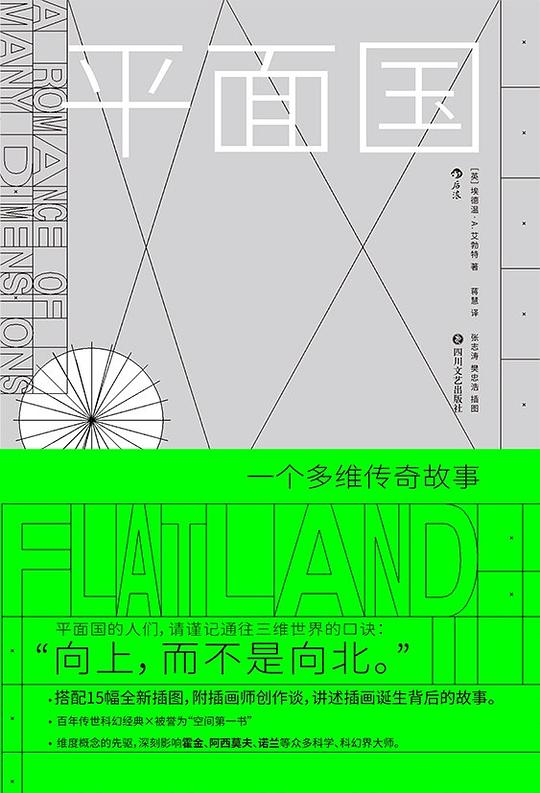
平面国:现实百年不衰小说
书名:平面国
1
0

名侦探柯南 2023-05-07 11:26:23
Edwin A. Abbotts most famous work is perhaps Flatland. The edition I read was the new illustrated hardcover edition published by Houlang. Although it is a short novella of only a hundred pages, it is by no means a simple text. This book, written in 1884, is full of ideas that interest mathematicians, physicists, historians, sociologists, politicians, and supernaturalists alike. It touches on eugenics, equality, revolution, the rigid class system of the late Victorian era, mathematical shapes, higher dimensions, deformations, and teleportation, among other topics.
The book is narrated by a resident of Flatland, a Mr. Square who happens to be a mathematician. The first half describes the houses, residents, and history of Flatland. From this, we learn that the lowest members of society, represented by straight lines, are females. They are considered stupid, emotional, and unsuited for education. While feminists may dislike this part of the book, it is an atypical viewpoint of Victorian society towards women, and the author is imitating this viewpoint. The book tells us that not educating women would have an adverse effect on the intellectual development of both male and female offspring.
The other shapes within Flatland reflect the rigid class system of society. The more edges a regular shape has, the higher its position in society. This ideal is ultimately embodied by circles, representing the political and religious leaders of society. All shapes aspire to have their offspring lead better lives and send their children to school for re-shaping, so they can enjoy better lives. Irregular shapes are deemed a threat to society and are either strangled at birth or imprisoned/executed in later life, either becoming criminals or revolutionaries.
The lives of most of the triangles, representing the working class, are a constant struggle. This latent dissatisfaction once led to rebellion. However, this cry for equality did not improve everyones life. Instead, an unbearable situation was created in which the middle class was dragged to an even lower level! The rebellion failed. Thereafter, the rulers manipulate the working class carefully, so that they fight amongst themselves.
In the second half of the book, Mr. Square has a dream where he lives in a single reality but has a vision of being transported into a three-dimensional reality by a spherical being. Then he has another dream where he experiences life in a reality with no dimensions. Mr. Square cannot make the one-dimensional residents, nor the sole non-dimensional one, understand the concept of a two-dimensional reality. Similarly, he finds it difficult to grasp the spherical beings explanation of three-dimensional space and struggles to make the other residents of Flatland believe or understand him. He even contemplates the possibility of four to eight dimensions. This part of the book involves concepts such as teleportation, omniscience, and deformation.
Observation is often suggested in a lighthearted manner, as when it is hinted that the Point is happy because he does not know any better, and no one around him bothers his simple thoughts with difficult questions. People realize that if the lower classes think that they or their offspring may eventually benefit from the current situation, they are more likely to accept an unequal society.
Several interesting questions are raised here, such as how much we really know and how averse we are to new ideas that threaten familiar ways of life. It shows how those in power manage the masses for personal gain.
This book should appeal to many readers. It is a severe indictment of the Victorian class society, which is still evident in todays world. For any creature living in different dimensions, this is also a profound portrayal of life.
相关推荐
萤火谷的梦想家
艾莉森•麦吉出生于1960年,是美国《纽约时报》畅销书作家,同时也是大都会州立大学创意写作课的教授。她的作品被翻译成20多种语言并出版,也曾被提名普利策奖,并获得苏斯博士奖金奖、克里斯托弗图书奖、美国 [美]艾莉森•麦吉/[美]克里斯托弗•丹尼斯/绘 2023-03-27 16:50:25鬼马女神捕1·绝密卧底(上)
腹黑凤凰vs毒舌鸡妖——蓝翎:“小姬,跟我去人界吧!”姬十四:“干吗?让人宰了我做小鸡炖蘑菇吗?”蓝翎:“不啊,让妖怪宰了你做小鸡炖蘑菇更气派。”凤凰蓝翎和鸡妖姬十四生活在无忧无虑的灵界。他们的故乡叫 郝天晓 2023-04-17 00:22:47© 2023-2025 百科书库. All Rights Reserved.












发表评价